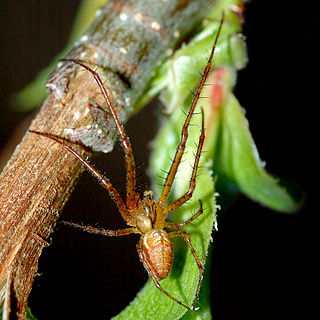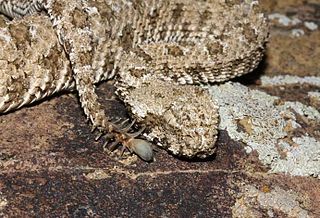
Latrodectus is a broadly distributed genus of spiders with several species that, together, are referred to as true widows. This group is composed of those often loosely called black widow spiders, brown widow spiders, and similar spiders. However, such general "common names" are of limited use as the diversity of species is much greater. A member of the family Theridiidae, this genus contains 32 species, which include several North American "black widows". In addition to these in North America are also the red widow Latrodectus bishopi and the brown widow Latrodectus geometricus, which, in addition to North America, has a much wider geographic distribution. Elsewhere, others include the European black widow, the Australian redback black widow, several different species in Southern Africa that can be called Button spiders, and the South American black widow spiders. Species vary widely in size. In most cases, the females are dark-coloured, but some may have lighter bodies or even reddish. Many can have red, white or brown markings on the upper-side (dorsal) of the abdomen. Some can be readily identifiable by reddish markings on the central underside (ventral) abdomen, which are often hourglass-shaped.

The recluse spiders, also known as brown spiders, fiddle-backs, violin spiders, and reapers, is a genus of spiders that was first described by R. T. Lowe in 1832. They are venomous spiders known for their bite, which sometimes produces a characteristic set of symptoms known as loxoscelism.

Ground spiders comprise Gnaphosidae, the seventh largest spider family with nearly 2,000 described species in over 100 genera distributed worldwide. There are 105 species known to central Europe, and common genera include Gnaphosa, Drassodes, Micaria, Cesonia, Zelotes and many others. They are closely related to Clubionidae. At present, no ground spiders are known to be seriously venomous to humans.

Crevice weaver spiders (Filistatidae) comprise cribellate spiders with features that have been regarded as "primitive" for araneomorph spiders. They are weavers of funnel or tube webs. The family contains 18 genera and more than 120 described species worldwide.

The spider genus Steatoda, in the family Theridiidae, includes about 120 recognized species, distributed around the world. One common name is cupboard spider, for many species build their webs in dark, sheltered, undisturbed places around the house or garden, in sheds and garages, under garden furniture, compost bins, and the like. Signs of the cupboard spider include small white spots of spider droppings, like small splashes of paint, on the floor underneath the web.

Menemerus is a genus of jumping spiders that was first described by Eugène Louis Simon in 1868. They are 4 to 10 millimetres long, flattened in shape, and very hairy, usually with brown and grayish hairs. Most species have white edges on the thorax. The abdomen is often oval, or sometimes elongated or rounded.
Iranattus principalis, synonym Monomotapa principalis, is a species of spider in the family Salticidae. It is found in Nigeria and Zimbabwe. Iranattus and Monomotapa were previously monotypic genera.

Salticus is a genus of the family Salticidae. Salticus is the type genus for the family Salticidae.

Metellina is a genus of tetragnathid spiders that occurs mostly in Eurasia, with two species found in North America. M. segmentata was introduced to Canada.
Iranattus rectangularis is a species of spider in the family Salticidae, found in Iran.

The Plexippini are a tribe of jumping spiders (Salticidae). They have also been treated as the subfamily Plexippinae. They are native to the Old World.

The spider-tailed horned viper and known as persian horned viper is a species of viper, a venomous snake in the family Viperidae. The species is endemic to western Iran, and was originally described in 2006. The head looks very similar to that of other Pseudocerastes species in the region, but the spider-tailed horned viper has a unique tail that has a bulb-like end that is bordered by long drooping scales that give it the appearance of a spider. The tail tip is waved around and used to lure insectivorous birds to within striking range.

Loureedia is a genus of velvet spiders that was first described by J. A. Miller in 2012. As of July 2020, it contained only four species: L. annulipes, L. colleni, L. lucasi and L. phoenixi. This genus of velvet spiders that live underground are named after Lou Reed, guitarist and singer for the Velvet Underground. In 2020, researchers discovered the fourth species, L. phoenixi, in Iran.

Caponiidae is a family of ecribellate haplogyne spiders that are unusual in a number of ways. They differ from other spiders in lacking book lungs and having the posterior median spinnerets anteriorly displaced to form a transverse row with the anterior lateral spinnerets. Most species have only two eyes, which is also unusual among spiders. A few species of Caponiidae variously have four, six or eight eyes. In some species the number of eyes will increase when the spiderling changes its skin as it grows towards adulthood.

Alireza Zamani is an Iranian arachnologist and taxonomist.
Paracedicus is a genus of Asian araneomorph spiders in the family Cybaeidae, and was first described by Victor R. Fet in 1993. First placed as a subgenus of Cedicus, it was elevated to genus status in 2003.
The Turkestani long-eared bat, Otonycteris leucophaea, is a species of bat found in Asia. Though it was initially described in 1873 as a species, for many years it was considered synonymous with the desert long-eared bat, Otonycteris hemprichii. Recently, it was recognized as a distinct species once again.

Thyene imperialis is a jumping spider species in the genus Thyene.
Iranotricha is a genus of ground spiders containing the single species, Iranotricha lutensis. It was first described by Alireza Zamani, M. Seiedy, A. Saboori & Yuri M. Marusik in 2018, and is only found in Iran.













